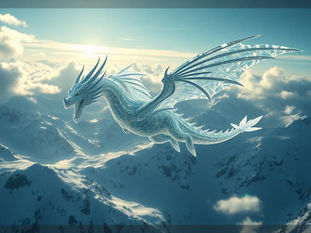
Midjourney Prompts: Get the Image You Actually Want (Stop Getting Raccoon Results)
May 3
4 min read
0
0
0

Are you using Midjourney but finding your images don't quite match what you picture in your head? You type out a careful description, hit enter, and get something... well, maybe beautiful, but not what you asked for? If you want to get specific results from Midjourney, especially with the latest versions, you need to understand how prompts work.
This guide will help you troubleshoot your Midjourney prompts. We will look at common reasons why your images might not turn out the way you expect and how to write prompts that give you more control over the creative process.
Why Midjourney Images Might Not Match Your Ideas
Midjourney creates images by guessing based on patterns in the data it was trained on. It takes your words, relates them to those patterns, and builds an image pixel by pixel.
But here's the catch: if you are not clear, Midjourney fills in the blanks. Think of it like a diffusion model guessing what you want. If parts of your prompt aren't specific, it will just make things up based on common defaults or whatever other words are in your prompt.
Another issue? Processing time. Even though Midjourney V7 is fast, if a prompt is too long or complex, the model can get confused. It might drop details or blend things in strange ways.
Ready to take more control of your Midjourney creations? The TitanXT Midjourney Automation Suite provides tools that can help refine your prompts and manage your workflows for more predictable and desired results.
Chaotic Tokens: The Gremlins in Your Prompt
Some words or phrases are like "chaotic tokens" for Midjourney. The model doesn't have a clear idea of how these words relate to pixels. This means they can lead to unpredictable results or simply be ignored.
What Makes a Token Chaotic?
Conversational Instructions: Telling Midjourney to "make a glass of wine, fill it to the top, and put it on a table" uses commands. Midjourney works best with descriptive language, not commands. For instructional needs, use conversational mode when available and appropriate.
Technical Jargon & Metadata: Terms like camera f-stops (f/2.8) or ISO numbers don't translate well to pixels. Midjourney doesn't simulate a camera; it creates an image based on visual patterns. While these words might be in the training data alongside images, their correlation to specific visual outcomes is weak and unreliable.
Abstract or Non-Visual Language: Words that don't have a clear visual representation are often ignored or misinterpreted. Words like "sophistication," "purity," or descriptions of feelings are hard for the model to translate into pixels. If you want something to look "serene," describe the visual elements that make it serene (soft light, calm water, gentle colors) instead.
Fidelity Claims: Saying things like "ultra-photorealistic," "hyper-detailed," or "8K" often does not make your image higher quality. Midjourney already produces high-quality images. These words usually just tell the model to aim for a photographic style, which you can achieve simply by using the word "photograph" or "photographic." Note: The word "realism" in art means a specific painting style, so using it might make your image look like a painting, not a photo.
Negation: Midjourney cannot understand what something *is not*. Saying "no leaves" is confusing. Instead, describe what *should* be there (e.g., "bare branches") or imply the absence by describing an isolated subject.
Word Salad: Just listing words without structure means Midjourney will guess at what you want. "Sunset crime eagle city cyberpunk" is unclear. Does "crime eagle" mean an eagle committing a crime? An eagle made of crime? An eagle in a city with crime? A structured prompt like "a cyberpunk eagle perched on a rooftop, neon city lights glowing at sunset" tells Midjourney what the subject is, what it's doing, where it is, and the time/lighting.
What Works Better?
Focus on words that describe visuals clearly:
Descriptive Details: Textures, colors, shapes, materials (e.g., "shaggy green carpet," "frosted glass," "red lace").
Positional Words: Terms that indicate location or arrangement (e.g., "left," "right," "middle," "perched on a rooftop," "isolated"). These are more reliable than "first," "second," "third."
Iconic Styles and Media Sources: Terms corresponding to known visual aesthetics work well. Names of famous photographers (like Ansel Adams), photographic formats ("Polaroid"), or media sources ("National Geographic magazine," "Vogue") often have strong visual correlations in the training data.
Controlling the Canvas: Subject, Background, Style
For more predictable results, aim to specify the three main parts of the image:
The Subject: What is the main thing the image is about? (e.g., "a mouse," "two people having coffee," "a white tiger").
The Background/Context: What is behind or around the subject? What is the setting? (e.g., "on a white background," "in a restaurant," "surrounded by cranes"). If you don't specify this, Midjourney might guess based on the subject or style, leading to unintended backdrops.
The Style: How should the image look? Is it a photograph? A painting? An illustration? In a specific artist's style or a particular aesthetic? (e.g., "photographic," "oil painting," "Banksy style," "Bauhaus style illustration"). If you leave this out, Midjourney might default to a common style like photographic.
When troubleshooting prompts, check if you have covered these three elements. Often, missed details are due to not specifying one of these key areas.
Refining prompts can be time-consuming, especially when trying to balance creative vision and technical adherence. Explore how the TitanXT Midjourney Automation Suite can streamline this process, helping you generate precise prompts and manage variations efficiently.
Structure, Grammar, and Punctuation Matter
Midjourney doesn't just look at individual words; it looks at word patterns and structure. Proper grammar and punctuation help Midjourney understand the relationships between the words in your prompt. Using commas to separate elements or describing things clearly in sentences rather than just lists of words helps guide the diffusion process more effectively.
Getting good at Midjourney prompting takes practice and experimentation. By focusing on visual, descriptive language, controlling the main elements of your canvas, avoiding chaotic tokens, and using clear structure, you will get much closer to creating the images you envision.
Conclusion
Congratulations on taking steps to improve your Midjourney prompting skills! By understanding how the model interprets your words and focusing on clarity and visual detail, you can move beyond random results and create images that truly match your creative intent.
Putting these principles into practice can take time. For advanced control and streamlined workflows, consider using the TitanXT Midjourney Automation Suite. It is designed to help you generate better prompts and manage your Midjourney projects easily.






